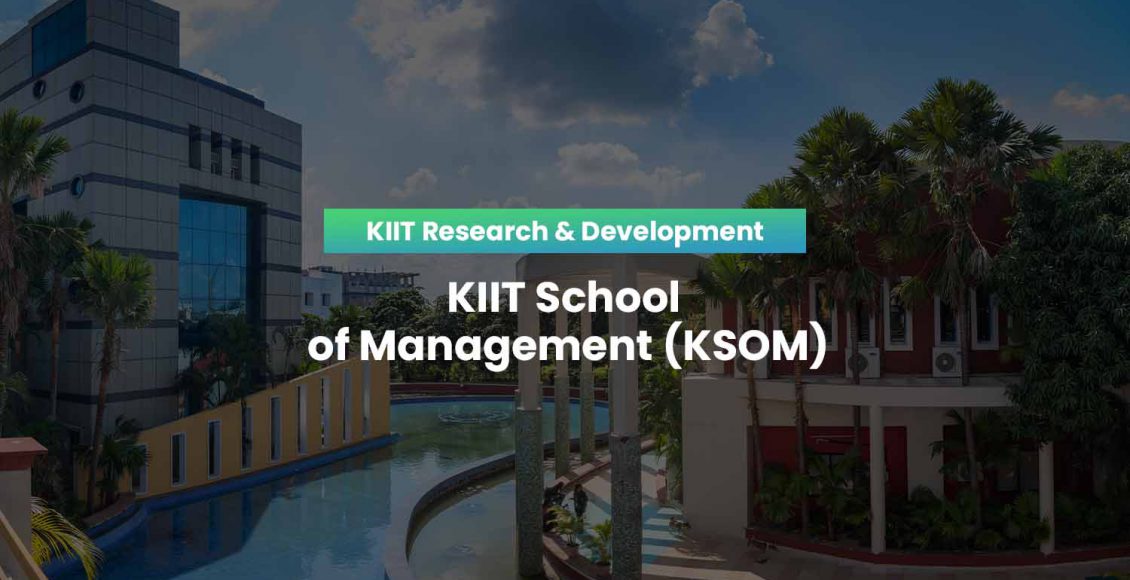School of Management (KSOM) (Oct – Dec 2022)
Journal Papers
1. Mishra, S., & Sahoo, M. (2021). Motivation to transfer soft skills training: a systematic literature review. Management Research Review, 45(10), 1296–1322. https://doi.org/10.1108/mrr-03-2021-0225
Abstract
Purpose: This paper aims to synthesize existing knowledge on trainee motivation to transfer (MTT) soft skills training through a systematic literature review (SLR). Design/methodology/approach: By applying a rigorous reproducible process, this SLR identified a total of 33 peer-reviewed articles on MTT in soft skills training. Findings: The systematic review offers several important findings. First, research on MTT has accelerated in the recent past with studies conducted in varied geographic contexts. Second, MTT has been operationalized and measured as an antecedent and mediator of training transfer as well as an outcome itself is sampled papers. Third, MTT is recognized as critical in facilitating the transfer of soft skills. Finally, an investigation of empirical studies helped locate gaps in research methodologies, measurement of MTT and finally its predictors. Research limitations/implications: The study is limited by the search string and its choice of peer-reviewed articles published in the English language only. Originality/value: In the absence of systematic reviews on MTT in the context of soft skill, the study contributes immensely by providing an updated, cogent summarization of extant work and potential directions for future research/practice.
2. Sar, A. K. (2022). The Dynamics of Social Inclusion of People with Spinal Cord Injury. Disability, CBR and Inclusive Development, 33(1), 89. https://doi.org/10.47985/dcidj.550
Abstract
Purpose: Social inclusion of people with disability is critical for maintaining social equity. The goal of this paper was to examine the dynamics of social inclusion of persons with spinal cord injury. Method: A cross-sectional research design was adopted to study the impact of individual, interpersonal, organisational, community and socio-political conditions on interpersonal relationships and community participation. Confirmatory factor analysis was used to validate the measurement models. Structural equation modelling (SEM) in AMOS was used to derive results. Results: The individual, interpersonal, organisational, community and socio-political conditions strongly influence social inclusion of persons with spinal cord injury. The strongest influencer of community participation is socio-political conditions (β=0.692 and p=0.001) and the strongest influencer of interpersonal relationships is organisational conditions (β=0.677 and p=0.001). Conclusion: Social inclusion, measured by interpersonal relationships and community participation, can be enhanced by improving the individual, interpersonal, organisational, community and socio-political conditions, thereby contributing to social equity and sustainable performance.
3. Das, S.L., Patnaik, B.C.M., Satpathy, I., & Das, S.C. (2022). A mathematical index model analysis of working capital management efficiency in the Indian private healthcare sector. Journal of Pharmaceutical Negative Results, 13, 1216-1221. https://doi.org/10.47750/pnr.2022.13.S05.193
Abstract
A hallmark of standard business management is the capability to maintain a strong balance between profitability, growth and liquidity by efficiently utilizing the working capital of the company. This study is an attempt to view the strategic perspective of working capital management policy and practices with respect to efficiency as well as profitability of Indian healthcare sectors. The newness of this study is, it did not use the conventional ratio analysis methods for its analysis, rather used mathematical index-based formula as well as regression to analyze the efficiency of working capital management and their causal relationships. Financial data of 30 companies listed in Bombay stock exchange (BSE) of India, were collected for the period of ‘2019’ to ‘2022’ for this study. Findings suggest that due to Covid-19, it has become challenging for private healthcare providers to maintain the financial health of the healthcare sectors due to over burdens of capacity building for Covid patients in hospitals. In this study period some companies were found less efficient in managing their working capital properly due to the reason the healthcare sector belongs to the service industry and efficient working capital management is a very challenging task for the company. It was suggested that finance managers or policy makers by increasing the utilization index be able to reduce the operating cycle of the company. Several researches were conducted on working capital management in the Indian manufacturing industry using conventional ratio analysis, but very few studies were done using this methodology during Covid-19 period in the private healthcare sector of India which belongs to the service industry. This study will be helpful for policy makers and practitioners of working capital management in various industries. This will give a scope to the future researchers for further study of working capital management practices in both manufacturing and service sectors.
4. Sar, A. K. (2022b). Price estimation for Amazon Prime video in India. Journal of Revenue and Pricing Management. https://doi.org/10.1057/s41272-022-00411-9
Abstract
There has been a considerable change in consumer sentiments toward over-the-top media services during COVID-19 Pandemic and after that. Following the changes in the consumer sentiments, marketers have repositioned there offerings aligning with the consumer willingness to pay. Accordingly, knowledge about consumers’ willingness to pay has become vital for success of the media service firms. The purpose of the paper is to estimate the price of subscription to Amazon Prime Video in India in the emergent context by gaining insights into the consumers’ willingness to pay. “Van Westendrop Price Sensitivity Model” was used to estimate the prices. The findings suggest an optimal price point of ₹1300/- per annum with a range of acceptable price between ₹1000/- and ₹1500 per annum. The estimated prices are consistent with prevailing prices.
5. Subudhi, R. N. (2022). Social Development Data and Societal Modelling: A Study in Indian Context. Studies in Big Data, 47–56. https://doi.org/10.1007/978-981-19-5154-1_4
Abstract
As we progress ahead and measure our growth in every field, science and technology or even societal development, every time, our focus is skewed and mostly myopic on what we achieved and what more to be done and how fast to be done. We seldom study what we really missed and skewed our development is. A retrospection and introspection, many a times, help us making a course correction. A development, or any economic growth, is no development if it is not for all and leaves a section of society. This paper looks at different social development models and important development indices which are in use today globally and analyses social development data in the Indian context. It refers to Mahalanobis D-square statistics and other Indian studies and attempts to suggest newer social development indices, using secondary data. It discusses issues relating to ‘social-big-data’, as available from secondary sources, published by various agencies. Paper presents a conceptual model for measuring the social wellbeing of individuals and families.
6. Ray, K. K. (2022). Customer Perception Towards Pradhan Mantri Jan-Dhan Yojana (PMJDY): An Empirical Investigation from Slum-dwellers Perspective. Millennial Asia, 097639962211187. https://doi.org/10.1177/09763996221118722
Abstract
The government-sponsored welfare programmes are instrumental in balancing economic growth and reducing inequalities in society. Society becomes inclusive only when the deprived people have access to banking and financial services. The policymakers and financial players emphasized the importance of financial inclusion programmes because of their significant impact on economic growth and the financial health of the economy. The Pradhan Mantri Jan-Dhan Yojana (PMJDY) is a government-led intervention programme with a national mission to provide banking facilities to all deprived sections in the country. The study focuses to examine the determinants of customer perception towards PMJDY. The study includes the slum dwellers of Bhubaneswar as the target group of beneficiaries for empirical research. The determinants include the delivery process (SERVQUAL) and outcome attributes associated with the social scheme. As customer perception is a categorical variable, the multinomial logistic regression model is adopted to test the hypothesis. The study results indicate that the beneficiaries consider reliability, assurance, tangibility and social connect dimensions as the likely factors to obtain a higher level of perception towards the welfare programme.
7. Mahapatra, N.R., Kumar, A., & Pani, S.K. (2022). Demand supply chain of online education for children in the VUCA world. International Journal of Early Childhood Special Education, 14(2). 7023-7028. http://dx.doi.org/10.9756/INT-JECSE/V14I2.811
Abstract
Education is the backbone of mankind’s progress. Every country wants their children to be exposed to early childhood education so that that they are not left out of the benefits of education. The early childhood education begins at home however once they are able to express themselves they need to have some formal education which will augment their cognitive as well as social interactions as well as the rest of the world outside their homes. Educational institutes play a great role here from early leaning methods as well as advanced schooling as they grow up. For all these they have to go out of the home and interact with other children, teachers with a face to face interaction with physical presence. This was a well-established model until year 2020. During COVID 19 pandemic the entire world experienced a challenge which was just against the 2 core concept of education, outing out of home and meets someone physically. Educational institutes all over the world had challenges life was sandwiched between lockdowns and unlocks and this was a never before challenge for them. Numerous individuals were the victims of the deadly virus which made the entire world a complex place to live in. these had a direct impact on the uncertainty aspect in individuals as well as with the educational institutes. While the entire world struggled to deal with the unseen, uncertain and undesired state affairs, the resiliency in human beings and educational models started accepting the struggle by adapting to the change the situation demanded for. Soon this acceptance helped educational institutes to be more resilient, productive and demand driven to run the educational activities as usual adopting the un-usual ways of education through completely online mode of education. Eventually education institutes and children learnt in the hard way that the world we live in is actually a VUCA (Volatile, Uncertain, Complex, and Ambiguous) world and at the same time continue imparting education to the children by accepting all changing parameters so that the educational outcome is achieved with resilience among all uncertainties. This study analyses the demand and supply chain of online education for children and proposes a paradigm shift that is required for education for children in time to come.
8. Sahoo, S.C., Ray, K.K., & Mitra, A. (2022). Exploring the Determinants of Life Insurance: a literature review approach. International Journal of Early Childhood Special Education, 14(2), 3616-3621. http://dx.doi.org/10.9756/INT-JECSE/V14I2.389
Abstract
This paper is a review of studies that focuses on the determinants of life insurance. An attempt has been made to unravel and lucidly explain the arcane literature and to bring to the fore, the elements necessary for exploring the determinants of life insurance. The authors utilized a form of explicit review of literature that emphasizes on determinants of life insurance in a cogent manner to engender new systems and viewpoints. A frugal conceptual model has been put forward connecting demographic parameters, market and economic parameters, economic benefit parameters and other parameters specific to life insurance. Therefore, further systematic study on the relation attaching demographic parameters, market and economic parameters, economic benefit parameters and other parameters specific to life insurance, emerge to be extremely pertinent.
9. Shukla, G., Kumar, A., & Bhardwaj, A. (2022). Impact of Product Performance on Retailer Satisfaction with Respect to Distribution Channel Strategy of Britannia Biscuits. International Journal of Early Childhood Special Education, 14(5), 2147-2166. http://dx.doi.org/10.9756/INTJECSE/V14I5.227
Abstract
Biscuit is one of the popular food categories in India. It is very widely distributed owing to its high levels of affordability. Companies have launched products addressing needs of diverse consumer segments. There are products in value segment starting as low as INR 3 per packet. On the other hand, there are premium products which go as high as INR 60 per packet. Consumer preferences are changing, and today’s consumer is more demanding than ever. Innovation has thus become a way of life for Biscuit companies in India. Consumers are doing an evaluation of several product attributes before selecting a product. Key product attributes include Quality, Taste, Freshness, Packaging, Brand Loyalty and Innovation. Retailers are the ones who make sale of products to the end consumer and thus get first-hand detailed feedback on product performance from the consumers. A positive consumer feedback on product motivates retailer to recommend products to consumers. On the other hand, a negative consumer feedback on product is likely to have an adverse impact on retailer recommendations with respect to the product. This is an important aspect as negative product feedback from consumer impacts retailer’s goodwill as well. Retailers expect quality products from manufacturers and performance of products impacts their satisfaction levels. 382 retailers belonging to Khordha, Puri and Cuttack districts of Odisha were surveyed on this aspect. Key dimensions of Product performance like Quality, Taste, Freshness, Packaging, Brand Loyalty and Innovation were studied. The purpose of this study is to understand the Product aspect in detail and assess its impact on the satisfaction of retailers with respect to Britannia’s Channel Distribution Strategy.
Conference papers
1. Gill, Karan Singh; Jha, Amaresh; Assylbekova, Aiman; Mishra, Isa (2022). Multimedia Systems and its Role in Adaptive Network Management. Proceedings of the International Conference on Sustainable Computing and Data Communication Systems (ICSCDS-2022) IEEE Xplore Part Number: CFP22AZ5-ART; ISBN: 978-1-6654-7884-7
Abstract
Multimedia systems are the systems that are capable of processing multimedia applications and data. This is characterized by processing, generation, storage, rendition and manipulation of the multimedia information. Additionally, adaptive network is the new approach, which expands upon autonomous networking concepts for transforming static networks into programmable and dynamic environments driven by intelligence and analytics. Autonomous network operates without much human intervention, and it configures, maintains and monitors itself independently. This research aimed to discuss the multimedia systems as well as its role in adaptive network management. It has provided a research rationale to discuss the issue and then use multimedia for effective adaptive network management. Moreover, this paper has provided a literature review, where it has provided the details of the multimedia system and benefits of it. In addition, it has identified some gaps from this literature so that in future other studies can mitigate these gaps by conducting better research. Moreover, the research has collected secondary data to get relevant information on the selected topic. It has been considered a secondary data collection method, because it is cost-effective and with help of it, this study could access the data of both primary and secondary research. Furthermore, the findings have suggested that multiple media systems are used for different purposes and enhance the adaptive network sector. However, the multimedia product is costly and it requires electronics that again increase the cost and that is why it is a huge advantage of multimedia systems
Patents (Published)
1. Dr. S. Balamurugan, Ankur Jain, Dr. Yogeesha H C, Dr. Isa Mishra, Umesh Kumar, Dr. Usha C. Pawar, Moidul Islam Judder, Dr.Amit Rameshrao Gadekar, Hemraj Shobharam Lamkuche, Dr.Sachin K Kamble, Patent Name: Sensor Based Intelligent Robotic Leg for Assisting Physically Challenged People using Reinforcement Learning (Indian patent) Published on 22nd July, 2022.
Abstract
Recent days have witnessed a steep rise in adoption of robotics and assistive technologies for aiding physically challenged people. Proposed is a Sensor Based Intelligent Robotic Leg for Assisting Physically Challenged People using Reinforcement Learning. According to the research conducted by World Health Organization (WHO), nearly 2 billion people in the world will be in need of assistive robots by the year 2050. Robotic leg is built with wearable sensors to monitor the movement of human limb and muscle activations. Zigbee sensor is used to monitor and record physiological parameters such as heartbeat, brain activity, sleep apnea, heart functioning, pulse and blood pressure. Stretchable Electrochemical Sensors id employed for blood glucose monitoring. For people suffering from Parkinsons disease, gait analysis is performed and moderated using Reinforcement Learning by on-shoe wearable sensor. Robot thus trained by Reinforcement Learning serves to be an effective assistive device for physically challenged people.
2. Dr. Sucheta Priyabadini, Dr. Shradha Padhi, Dr. Isa Mishra, Dr. Debi Prasad Das, Patent Name: Women Tribes in Transition Among Alien Environment In Urban City (Indian patent) Published on 9th Dec, 2022
Abstract
Women tribes in transition amid alien environment in urban city described herein. It analyses existing status of tribal women in the fields of livelihoods trend and occupational pattern, implication of social mobility, 5 indigenous cultural practices and working conditions in unorganized sector. It tries to assess women security and sustainable dignified livelihood opportunities in the urban city of the migrated tribal women. Involvement and contribution of women worker in the informal economy have been analyzed in terms of efficacy, actual availability of wages and 10 work site facilities and actual outlays as well. However, tribal women migration highlights the policies, rules and regulation for the tribal women relating to their security and dignity of life. Hence suggested recommendation and study findings may helpful both for government and other associated agencies those are actively involved in social 15 development sector for better strategic programme implementation and broad understandings of women issues at large scale.
Patents filed
1. Dr. Debidatta Das, Dr. Isha Mishra, Dr. Tapan Kumar Bastia, Amit Vikram, Dr. Biswa Bandita Kar, Dr. Bansidhar Mulia, Dr. P. Karthigeyan, Patent Name: Robotic Laryngscope for Throat (Indian patent) Applied on 21st April, 2022.
Ph.D. Degree Awarded (Provisional)
Scholar Name- Tarun Shyam
Supervisor Name- Dr. Srikant Charan Das
Thesis Title: – Digital Divide in Higher Education System in Odisha
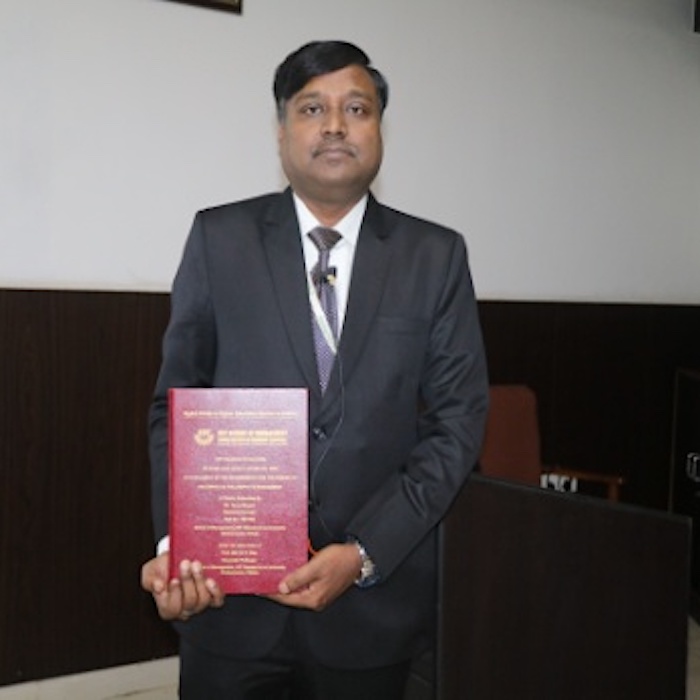
Abstract:
Technological change is a major contributor to the growth and development of theinformation society. Unequal access to information and communication technologies leads todigital divide and affects the growth and development of the society by powering somepeople who have availability of information and depriving others who do not have access to information (Malhan, I. V., 2003, et.al). Digital divide is the differential in access and use ofinformation and communication technologies (ICT) represents an obstacle to the informationsociety and ICT use is mainly influenced by habit, ICT skills, and benevolence. (Goncalves,c2018). A digital divide is any uneven distribution in the access to, use of, or impact ofinformation and communication technologies (ICT) between any numbers of distinct groups.These groups may be defined based on social, geographical, or geopolitical criteria (NITA,1995).Several digital divide scholars suggested that a shift is needed from a focus on binary Internetaccess (first-level digital divide) and Internet skills and use (second-level digital divide) to athird-level digital divide in which the tangible outcomes of Internet use (Scheerder, A., 2017).The outcome of the internet can be beneficial and non-beneficial, which has not been explored with respect to third level digital divide. So, proposed study can be carried out for identifying outcome of internet use and study the gap among all stake holders of Higher Education System. In Higher Education System, the stakeholders face challenges of digital divide. The type ofdigital divide is yet to explored in Higher Education System in India. So, the study will be carried out among the stake holders of the Higher Education in Odisha. The stakeholders tobe considered are students, faculties and administrative staffs of Higher Educational Institutes.This research will help to identify and make awareness of the digital divide in Higher EducationSystem which enable the policy maker to amend policy in future to minimize the gap occurringdue to digital divide. This research will indirectly help the student as well as the other stakeholders to access and get benefit from use of digital consumption.Keywords: Digital Divide, Digital Consumption.
Scholar Name- Sajal Kumar Ghosh
Supervisor Name – Dr. Ashok Kumar Sar
Thesis Title-
The Dynamics of Project Success: A Study of Railway Construction Projects in India
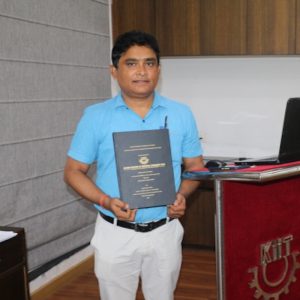
Abstract:
Purpose: To investigate the effects of project organizations’ structure, project management processes and project management systems on project management success measured by project’s completion time, cost, and quality. Design/methodology/approach: Three organizational theories, such as, structural contingency theory, process theory and systems theory are used as theoretical background for this study. Responses from railway construction project professionals in India in a seven-point Likert scalewere collected for the study. Partial Least Structural Equation Model (PLS-SEM) by Smart PLS3.3 statistical software was used for data analysis.Findings: Results revealed presence of significant positive effect of project organization’sstructure on project completion time but no significant effect on project cost or project quality inrailway construction projects.It was also found that, Project management processes of the construction organizations have significant positive effect on project cost and project time whereas project management systems have significant positive effect on quality of project output and project time.Implications: Keeping in view of the increased importance of construction project success, and increasing numbers of railway construction projects, the findings of this research study will helpconstruction project professionals in taking proper organizational decisions according to the priorities of their projects either to complete it within time, or within cost, or within scope/quality or with all of these success criteria.The finding will also be useful for future researchers in understanding the role of different organizational success factors in achieving construction project’s success criteria.Originality/ Novelty: This research used three project success criteria as dependent variables instead of using overall project success as done in earlier studies in the project management arena.Keywords: Project Structure; Project Management Process; ProjectManagement system; Railway Construction Project; PLS-SEM
Scholar Name-Devesh Rath
Supervisor Name- Dr. Ipseeta Satpathy
Thesis Title-Entrepreneurship in Odisha: Challenges & Opportunities
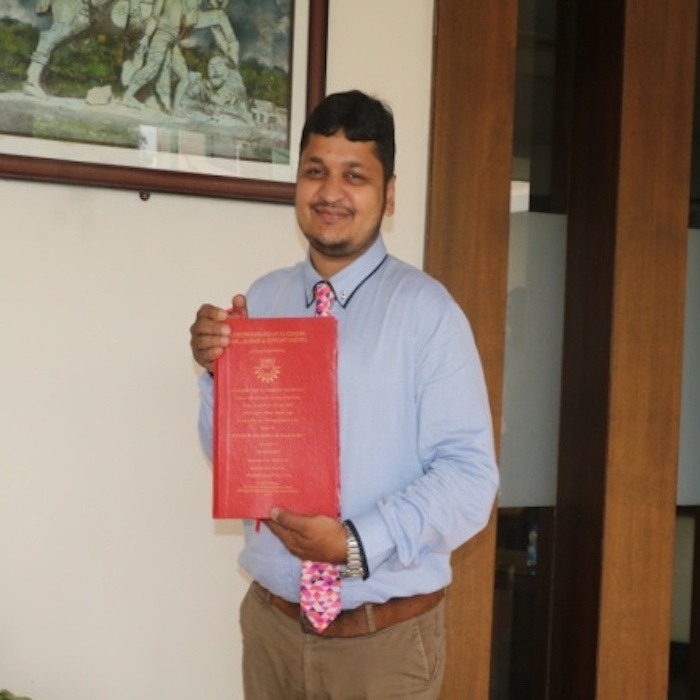
Abstract
In order to be considered an entrepreneur, a person must have a desire to make money while alsomaking a positive impact on the world. He sets up, organizes, manages, and bears the risk of abusiness in order to make money. Any firm, especially a brand-new one, has some level of risk.The believer of menace enthusiastically initiates a state of the art firm in order to obtain financialgain and the opportunity for social mobility. As part of this quest, he collects the resourcesnecessary to take advantage of the opportunities that arise.Many risks and difficulties must betaken by an entrepreneur in order to generate a profit and bring new ideas, goods, and services tothe public. Instead of taking a job, he’s a brilliant thinker who makes a significant contribution tosociety’s economic well-being. It is the process of starting, organizing, running, and benefitingfrom a business that is called entrepreneurship. These factors have led to the development ofmore problem-solving-oriented definitions than those seen in the past.To be fair to entrepreneurs, they can provide solutions to a wide range of issues and difficulties. When startinga new business or venture, there is always the risk of losing money that could lead to itsextinction. Entrepreneurship’s most crucial component is this. Unemployment and the inability to create new jobs in India threaten the country’s economicgrowth. Governments in India have found it more difficult to keep pace with the country’s increasing population.No government can guarantee a steady supply of jobs without asignificant increase in the number of businesses and entrepreneurial endeavours. In order to close the gap between job opportunities and unemployment among Indians, large-scaleentrepreneurship and the establishment of corporate firms are essential. It’s vital to rememberthat a large portion of India’s population is under the age of 30 and many of them areunemployed.A greater number of young people are seeking employment after graduating from college, and this trend is projected to continue in the coming years. Entrepreneurship has beenwidely recognized with improving living conditions and boosting per capita income, as well asproviding new sources of finance for the government. Although the importance ofentrepreneurship is widely accepted, it is challenging to persuade people to chooseentrepreneurship over Job Opportunities. Finding and establishing successful entrepreneurshipopportunities is a challenging endeavour. Due to several challenges and difficulties that entrepreneurs confront, becoming an entrepreneuror launching a new business is not for everyone. Understanding the fundamental roles ofentrepreneurs is the first step in understanding entrepreneurship as a whole.Entrepreneurial Success is Influenced by a Wide Range of Factors and Variables, like:Demographic Profile: Indicators of a person’s background, such as age, gender, andeducational attainmentPersonality: Desire for success, risk-taking ability, independence, interest, expertise,leadership abilities, motivational level, and a thirst for growth are all examples of aspirational traits.Social Factors: Parental Role, Culture, Family & Friends Support, etc.Environmental Factors: Lack of Employment Opportunity, Resources, EconomicCondition etc.Other External Factors: The political, social, cultural, economic, legal andtechnological environments. The concluding observational factors based on the study of entrepreneurial challenges andopportunities in the state of Odisha categorized into Entrepreneurial Challenges and Opportunities, Personality Traits & Psychological Traits, Demographic & Motivational Factors, Pandemic & Corona Virus: Covid-19, Demonetization, Goods & Services Tax (GST), Incubators& Accelerators impacting their Business Performance confining to the two districts of Khurdha or Bhubaneswar & Cuttack having the functioning of maximum numbers of Start-ups and MSMEs are as follows.Males are more subjected to entrepreneurship than females, but however the trends are changingfrom past now many females are also taking entrepreneurship as career.Majority of entrepreneurs comprises of youth in the age group of 30-40 years, apart from that various agecategorization entrepreneurship ecosystem has been expanded. Study shows maximumentrepreneurs under married status opt for entrepreneurship in comparison to unmarried. It seems that entrepreneurs in Odisha belong to well educated society with pivotal importance toeducation is given which mostly may help them in their entrepreneurial journey.Majority of entrepreneurs in Odisha are better believer of practical professional experiences and skillacquisition before initiation of any kind of entrepreneurial venture by them so as to limit the riskfactor and which mostly may help them in their entrepreneurial journey. The general categorymajority of entrepreneurs in Odisha prefer to choose entrepreneurship and new venture creationas the best career option as per their convenience despite of India as a country being under reservation category for different classes of caste.The general upper middle class backgroundrespondents are more likely to pursue entrepreneurship as career than other background people inthe society. Thus, the private limited entity is the most preferred choice among entrepreneurs based on its pros despite of any corns associated with it as there is growing no. of start-ups in the state of Odisha with new age entrepreneurs motivated towards startup ecosystem and modernization.The statistics coveys that in recent passed more number of entrepreneurs have engaged themselves into entrepreneurial ecosystem. The response in Bhubaneswar is more dueto its identification a startup hub with presence of majority numbers of business incubators, accelerators, start-up commercial spaces etc and presence of many start-ups in the region activelyinto new age entrepreneurial ecosystem.Better infrastructural facilitation is mostly preferred byentrepreneurs for their business location operations. With 5 no’s of team size is more as mostly start-ups work on effectively team size with best resource optimization. The study observed that there is association and the personality and psychological traits like, Need for Achievement, Need for Independence, Locus of Control, Risk Taking Propensity, Innovative & Creative thinking are the major factors are responsible for entrepreneurial businessperformance along with the development of the entrepreneur.
Scholar Name- Tapaswini Pattnaik
Supervisor Name- Dr. Sasmita Rani Samanta& Dr. Jitendra Mohanty
Thesis Title- Work Life Balance of Health Care Workers in New Normal
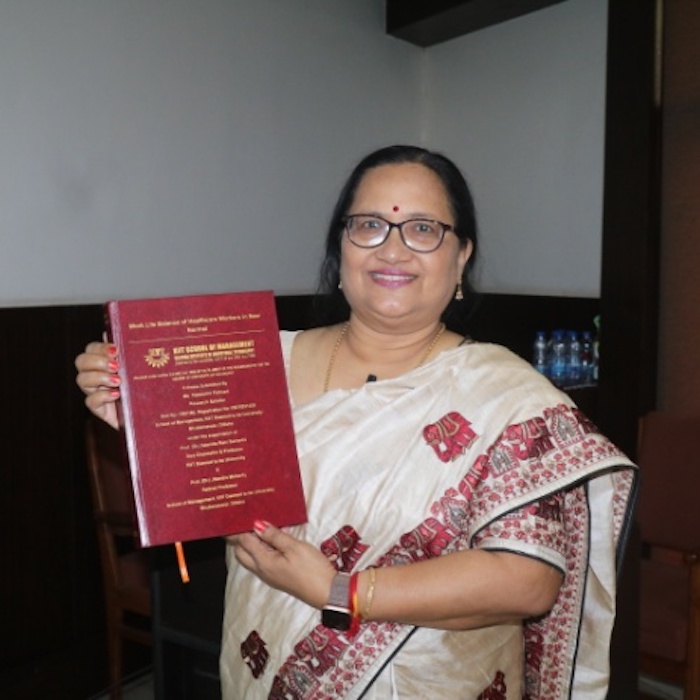
Abstract:
The balance of work and life has become a serious challenge in a society full ofcontradicting responsibilities and commitments. Professional-life balance (WLB) is defined as a state of equilibrium in which an individual’s work and personal obligations are balanced. Work-life balance is critical for human resource development.Carlson and Grzywacz (2008) showed that work-family balance was at the core of the primary objectives of human resource development, either implicitly or explicitly, and that it was a powerful lever to enhance individual and organizational efficiency.The phrase "e; work-life balance "e; was coined in 1986, but its use in daily English was patchy for several years. Intriguingly, work-life services were already available in the 1930s.According to HR professionals, the WLB is critical for employee engagement and work satisfaction. The WLB is asignificant factor. It is the line that separates professional life from personal life, separating the job, business, trade, and all other aspects of an individual's existence that add up to their whole life. The WLB can achieve the ideal balance between work and other aspects of life (Kaliannan et al., 2016).This thesis is part of a doctorate program in management. The concerns of healthcare workers have long gone ignored among the myriad challenges affecting the Indian healthcare system. In order to contribute to the personal development of health-care professionals, hospitals must take a number of actions to make their occupations more gratifying and meaningful.To that end, the current study is aimed to fill a knowledge gap in Indian healthcare by focusing on physicians and other healthcare professionals, as well as their work-life balance and difficulties in the new normal condition. Identifying and understanding factors related to health care workers' work-life balance problems in India is the primary objective of this study. The study also explores their expectations for different work-life balance systems in hospitals.
Scholar Name- Sanjaya Kumar Ghadai
Supervisor Name- Dr. S.N Misra & Dr. Damodar Jena
Thesis Title- Local Community Participation in Success of Integrated Child Development Services: An Empirical Study in Khordha District of Odisha
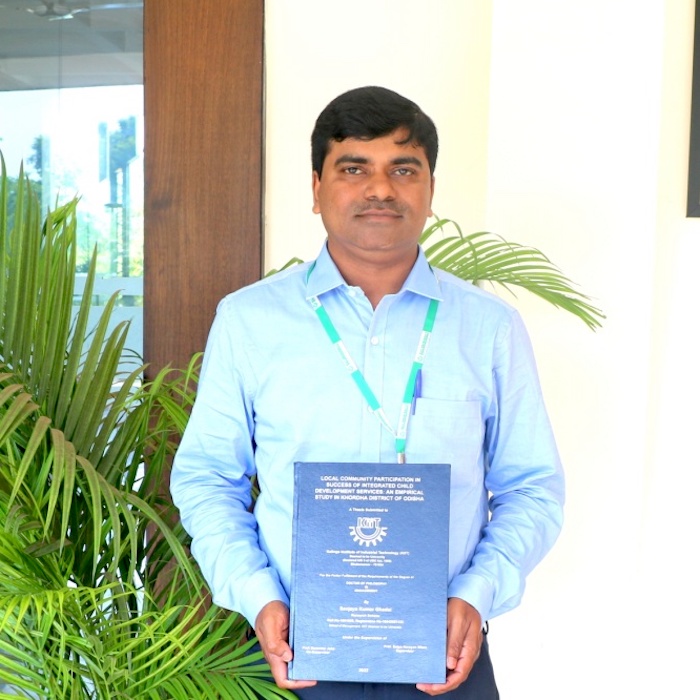
Abstract:
India launched the Integrated Child Development Services (ICDS) programme in 1975 with a view to improving nutritional and health status of children in the age group of 0-6 and of pre-natal and post-natal mothers, providing basic health care and imparting Early Childhood Education in the Anganwadis.The present research is anattempt to make an assessment of community participation and the effectiveness of theICDS programme by adopting the Knowledge, Attitude and Practice (KAP) model. The research objectives include ascertaining KAP of respondents, measuring the extent of community participation and effectiveness & identify the problems that hinder community participation.The major findings have been that Anganwadi centres helps in improving the attitudinal level of beneficiaries. In terms of participation, the beneficiaries are least involved in organizing meeting with local leaders. The majority of the respondent takes active part in nutritional programme, health check-up and immunization. The study also shows that higher education level contributes to higher participation in the community programmes. While the beneficiaries are satisfied with the performance of the AWC staff and immunization, the least satisfaction has been noticed in health referrals.The problems that hinder community participation are distance followed by shyness of the respondents. Theurban beneficiaries seem to have higher problems compared to the rural beneficiaries. Mothers of pre-school children seem to be least enthusiastic in communityparticipation. The research has important implication for the policy makers to reviewthe effectiveness of early childhood education, providing better health care supportservices and creating enabling environment for education, skill inculcation of the female respondents.
Scholar Name-Sekhar Chandra Sahoo
Supervisor Name- Dr. K.K Ray
Thesis Title- Aversion, Indifference and Propensity towards Life Insurance: Role of Insurance Literacy, Advisors and Information Sources
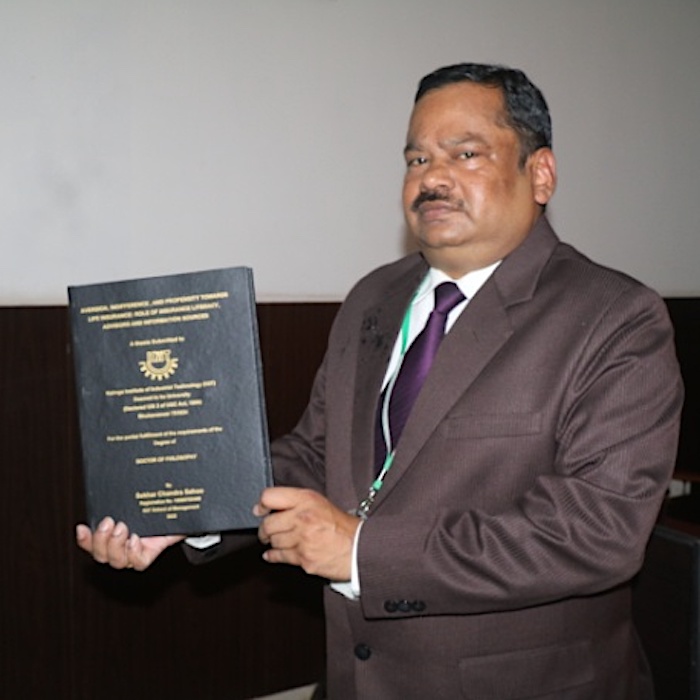
Abstract:
The relationship between the customers and the product has been there since the origin of business. Customers tend to have their own behaviour towards different products. And this behaviour is guided by certain pre-conditions, cognitive-biases which are long term results of information knowledge, exposure, experience etc.As businesses became competitive, business-houses decided to become smarter and thus, this relationship became a topic of observation and analysis. Unlike majority of the products in the market from various sectors, “Life Insurance” is an intangible product. This intangibility nature of the product makes the study of the relationship between the product and the customer difficult as well as all the more important.The objective of the present study is to establish and analyze the relationship that exists between theelements such as Insurance Literacy, Advisors and Information Sources and their impact on the behavior of the customer towards life insurance purchase.In Indian context, even today, life insurance is sold but not bought. This shows that the customers are averse to life insurance. If customers are averse, indifferent or inclined towards life insurance, do the elements mentioned above have any contribution in it?The current market of life insurance operates without taking in to account the importance and impact of the elements on the behavior of the customers towards life insurance. As such, the attitude of the customer towards life insurance is formed without proper literacy, advice and information, which is evident from the low insurance penetration of 3.2 percent of GDP in India.The study has its unique importance. Two such points must be noted. First, how the elements such as roleof insurance literacy, advisors and information sources impact customer behavior and second, how theinteraction between these elements can help us improve the odds of a positive customer behavior. Ineffect, the study can be used to work on moving the customer behavior from aversion to propensity towards life insurance.The study proposed the following objectives to investigate:1. To investigate whether life insurance purchase decision is dependent on age, gender and incomelevel.2. To investigate how other investment opportunities contribute towards aversion in life insurance.3. To study the role of advisors in life insurance decision making.4. To investigate the impact of information sources in deciding the life insurance policy.5. To devise a life insurance literacy index6. To study the investor’s personality towards purchase of life insurance products.7. To study how aversion adds towards under-insurance in life insurance.8. To investigate the factors underlying customer perception towards investment in life insurance.The research is exploratory in nature. The stratified random sampling technique is followed to collect the data with a structured questionnaire.The sample data includes two levels of stratification i.e. age and insured/uninsured. The sample respondents are classified into three categories on the basis of three age groups (Gen X, Y & Z) with insurance subscription and not subscribed of any insurance policies (3*2). The primary data was collected from adult population across India consisting of over 5000 respondents.The empirical findings suggest that age, gender and income level are influencing factors for purchasing life insurance policies. The researcher also studied the investors’ personality towards purchase of life insurance products and concluded that the Life insurance purchase decision is dependent on Personality trait 1(Introvert Extrovert), Personality trait 2 (Stubborn Agreeable), Personality trait 3 (Careless Sincere), Personality trait 4 (Anxious Confident) and Personality trait 5 (Traditional Open).A Life Insurance Literacy index was also prepared which comprises of 15 questions divided into 3 categories of basic questions on life insurance, introduction of life insurance and financial planning.After exploratory factor analysis it resulted into single factor (largest factor in terms of total variance explained) to construct a life insurance literacy index consisting of a few unique questions. The research scholar explored the levels of Life Insurance literacy amongst X, Y & Z generations.The empirical findings suggest that life insurance literacy among insured people is higher than that of uninsured people. Generation X is having the highest life insurance literacy whereas generation Y is the lowest. The focus was also to find the other alternative investment that is influencing the adverse decision towards life insurance products. For investigating the contribution of other investment opportunities as alternative to life insurance, the uninsured respondents were divided into 3 categories i.e. a) High income group, b) High savings group and c) High income and high savings group as investment activity of an individual relates to her/his income potential and savings habits. It is concluded that FD/RD and Gold/Silver are preferred across all categories as alternative investment to life insurance.A logistic regression analysis was conducted to test the correlation between variables of Advisors and their propensity of purchasing life insurance. The research scholar established that easy accessibilityof insurance advisors (ACCESS), providing correct information (CORR_INFO), and Insurance advisors inform and guide the customers (GUIDE) are positively & significantly associated with the purchase of life insurance, and also their odds ratio are higher than that of Insurance advisors have proper knowledge and competence (KNOW_COMP).Insurance advisors having proper knowledge and competence (KNOW_COMP) has fairly non-significant influence on the propensity of purchasing life insurance as the odds ratio is only 0.942.To explore the determinants of life insurance purchase decision an exploratory factor analysis isconducted on 26 key variables to differentiate between relevant independent factors that dictate thedemand for life insurance. The analysis resulted in four main factors namely company related factors, benefit factors, personal factors and household income and family security.The empirical findings suggest that Premium, Company Image, Brand Name, Overall Financial Satisfaction, Service Quality, Ease in Procedure, Company-Client Relationship, Satisfaction level, Secure Investment & Companyloyalty (Company related factors); Bonus & Interests, Charges, Accessibility, Rider Benefits, Tax savings(Benefits factors); Household Income, Family Security (Household Income and Family Security factor)are the important determinants for availing life insurance policies. Further, logistic regression model isemployed to test the association between determinant factors of life insurance purchase and the propensity of purchasing the life insurance policies.The study confirms that company related factors, benefitsfactors, household income and family security strongly stimulate the demand for life insurance, whereas the personal factors is found not to influence the propensity of purchasing life insurance.The Exploratory Factor Analysis (EFA) was done on 3414 under-insured cases for knowing the reason fornot taking insurance or not having adequate insurance as well as how aversion adds towards under-insurance in life insurance. The study confirms that Lack of buying intent factor , Poorly informed factorand Financial Restraint Factor add towards under-insurance in life insurance adding to aversion. This study is an attempt to explore the high influencing factors of Life Insurance on customers in a developing country like India. The outcome of this research provides a valid basis for life insurance policy decision makers to concentrate upon key variables as potential drivers of demand for life insurance. The findings of this research may be helpful to the insurance companies to identify insurance literacy and factors to redesign their products as per the requirements of the different groups of customers.The present study will help life insurance companies for market segmentation, targeting & positioning of life insurance products. Providing financial education will definitely enhance life insurance literacy. Even though having high life insurance literacy, the reasons of low life insurance penetration may be an area of research for future for the researchers working in the field. “ Human Life Value (HLV) is the present value of all future income that one could expect to earn for his/her family and help in determining life insurance needs on the basis of one’s income, expenses, savings and liabilities”. The findings are important to the Government, life insurance companies and the public as well as theFindings demonstrate that life insurance literacy plays a crucial role while purchasing life insurance. The findings of the study gives a new analytical direction to the public at large as well as Government and life insurance literacy literature, which will promote life insurance penetration in India. Even though being life insurance literate, very high percentage of respondents are not insured the reasonsfor which may be lack of fund, inappropriate information towards life insurance, not being approached byproper insurance advisors, or lack of intention. This may be taken up for future research studies by theResearchers working in the field.Keywords: Aversion, Indifference, Propensity, Insurance literacy, Determinants of Life Insurance Purchase Decision, Life insurance literacy, Life insurance.
Scholar Name-Kumar Devdutta
Supervisor Name- Dr. Abhishek Kumar
Thesis Title-Implementation of GIS in Sarva Shiksha Abhiyan in Odisha
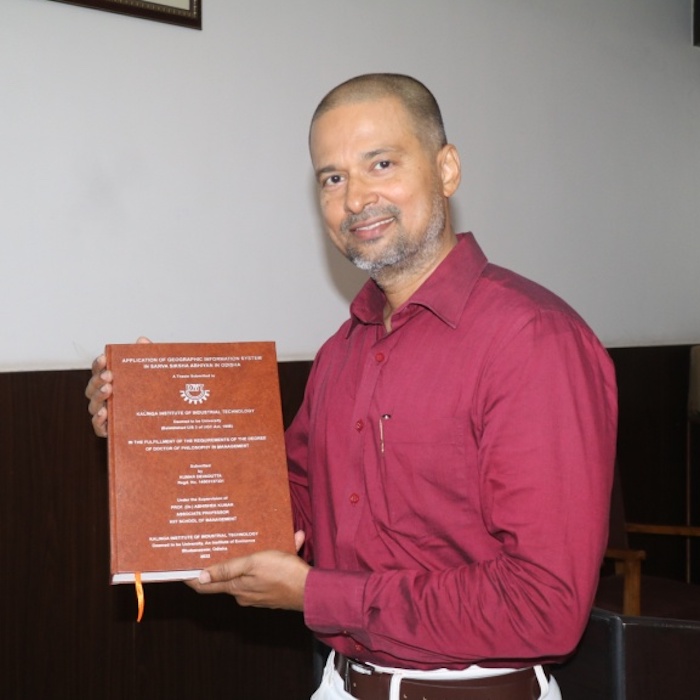
Abstract:
Education is the most important tool for social, economic and political transformationand a key instrument for building an equitable society. A well-educated population, equipped with the relevant knowledge, attitudes and skills is essential for economicand social development in the twenty-first century.Education also acts as anintegrative force in society, imparting values that foster social cohesion and national identity. Before 1976, education was the exclusive responsibility of the States. The Constitutional Amendment of 1976 included education in the Concurrent List. Whilethe role and responsibility of the States in education remained largely unchanged; the Union Government accepted a larger responsibility of reinforcing the national andintegrated character of education, maintaining quality and standards including thoseof the teaching profession at all levels, and the study and monitoring of theeducational requirements of the country.With the formulation of National Policy on Education (NPE), 1986, India initiated awide range of programmes for achieving the goal of Universalisation of Elementary Education (UEE).These efforts were intensified in the 1980s and 1990s throughseveral schematic and programme interventions, such as Operation Black Board(OBB), Shiksha Karmi Project (SKP), Andhra Pradesh Primary Education Project(APPEP), Bihar Education Project (BEP), U.P. Basic Education Project (UPBEP),Mahila Samakhya (MS), Lok Jumbish Project (LJP), District Primary EducationProgramme (DPEP) and the Sarva Shiksha Abhiyan (SSA) – the flagship CentrallySponsored Scheme in partnership with State Governments for UEE across thecountry.This was further strengthened with the passage of the Right of Children toFree and Compulsory Education (RTE) Act, 2009 which gave a legal mandate toprovide free and compulsory elementary education to every child in the age group of6-14 years.States and UTs were supported in the implementation of the RTE Act, 2009 throughthe Centrally Sponsored Scheme of SSA. The norms of the Scheme were aligned withthe provisions of the Act.The Goal 4.a states that “Build and upgrade education facilities that are child,disability and gender sensitive and provide safe, non-violent, inclusive and effectivelearning environments for all”. To facilitate and foster elementary education, the Government of India envisioned toimplement one of the flagship initiative in the education domain that is Sarva Siksha Abhiyan [SSA].SSA encourages & encompasses the universalization of ElementaryEducation for the age group of 6 – 14 years children. This education will be impartedfree of cost. The education is free, books distributed free, school uniform is providedfree. There are special incentives & stipends to girl child. Further, inclusive educationhas been embraced & emboldened in to the initiative. Profound and prudentprovisioning has been made to provide special care to the Children With Special Need [CWSN].The equipment are made available to the children, the resource persons arewell trained to extend personal care extensively & expansively. Further, to advocategender equality at elementary education, SSA incorporates the necessary & essentialelements. Considering the geographic spread & demographic mix, the SSA initiative has beenconsidered as one of the prodigious initiative with massive investment of resourcesand a large pool of human capital.This has a gigantic, scalable, extensible, reliable& robust operational framework. SSA infrastructural spread takes into account the existing elementary schools and upgrades them to accommodate the requirements. Further, new schools are established under this initiative with SSA compliance. Some of the salient features of the initiative: It introduces a holistic approach to education. it develops an ecosystem to advance &aggrandize the inclusive education at elementary level.Administrative reforms are made to offer a simple, smooth & sustainable operational framework. Continuous and consistent focus is appraised and acknowledged to provide quality education. Capacity building of Teachers & school Head has been enhanced .moreemphasis is given to tech intervention. Creating nodal centers to groom teachers & other stakeholders to uplift the competency level . Special attention is given to upgrade the science & math talent by establishing domain specific curriculum /school. Girl education & girl safety is under constant supervision, possible measures are taken to support the agenda. Sports and physical education helps in the overall development of the children. Utmost care and concern has been extended to encourage sports in school.The post implementation result was explainingthe acceptance & appraisal of the new system and realize the cause of delay and couldbe able to minimize it substantially.Hence, the study ended with the conclusion & conviction to implement real-timelocation based monitoring system to facilitate the distribution process & minimize thedelay in delivery of goods & services which in turn retains the foot fall and increasesthe enrollment in the school under the SSA initiative.
Scholar Name- Sweta Mishra
Supervisor Name- Dr. Shikta Singh
Thesis Title- Web-Store Nudges Influencing Healthier Food Choices
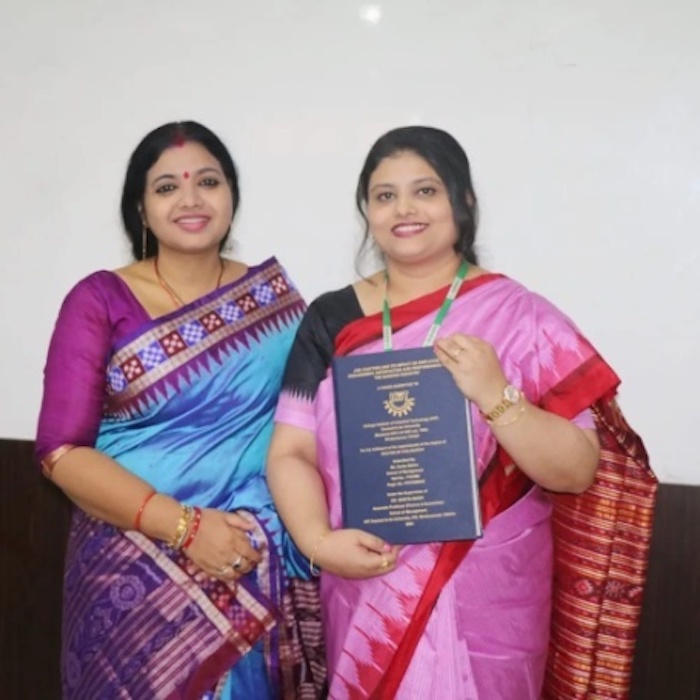
Abstract:
Job crafting is a new concept in today’s scenario and it has its applicability in all aspects. This concept has emerged as a requirement to rebuild and redesign the monotonous duties assigned to employees and give them a feel of newness in their work. Such a concept makes way to attract employees to their workplace and engage them in executing their duties and responsibilities.Here comes the concept of Employee Engagement which attracts and retains the talented mass in the organization. Considering these two concepts moving in a positive way makes the employees contended in their position. This means that the employees get satisfaction when they craft their job and engage themselves completely in their work. Such satisfied employees work to their level best to achieve their targets. We can say that the employees when happy and satisfied perform better and enhance their overall as well as achieve the goals of the organization. These four concepts are closely linked to each other and such relationships give rise to workforce marching ahead in a positive direction to achieve their targets and take their organization to a new level of success in this competitive market. The economy is growing and the financial sector is the strongest pillar on which the economy rests. When employees in this sector are givensuitable opportunities to implement such concepts, then they can revive and reach the peak of their success in less time. The current pandemic wave of Covid-19 has also brought down all sectors below their normal working and implementing such new concepts will definitely help the industries revive and again work at a normal pace.For the research work, the banking sector has been selected as it is a vast sector with massive workforce and forms the backbone of each economy. It has been done in the capital city of Odisha, i.e., Bhubaneswar taking into consideration several branches of SBI and Axis bank. This study deals with the existence of job crafting in the banking sector, its impact on employee engagement, satisfaction and performance and also studies the inter-relationship between employee engagement, satisfaction and performance in public and private sector bank.Further, the study deals with the precautionary measures taken during the Covid-19 times and which all measures are followed by the employees in both the sectors. Several variables taken from literature as well as from communication with few employees for the three constructs like engagement, satisfaction and performance were put in a questionnaire format and the data was collected.The questionnaire based on job crafting was an established one I and it was also used to collect data. The pilot study was conducted with 75 responses from bankers with the help of structured questionnaire using 5-point Likert scale. The variables were clubbed into major factors analyzing by exploratory factor analysis and the impact was studied. For the final survey, 289 responses from the banking employees were considered and analyzed from both sectors.There were 11 major hypothesis and several sub-hypotheses to conduct the study meticulously. For the analysis portions, the impact or existence of job crafting in the banking industry was studied doing ANOVA tables. Then, to analyze the effect of job crafting on employee engagement, employee satisfaction and employee performance regressions were done and studied. Further, to analyze the inter-relationships between employee engagement, satisfaction and performance, confirmatory factor analysis and structuralequation modelling was done using the variables and the inter-relationships were studied regarding the banking sector.Lastly, the precautionary measure was considered during the pandemic times and its impact was studied in public sector and private sector banks. The analysis depicted that job crafting existed in the banking sector but it was essential to practice it even more and use it for long run. It was found that more of task crafting existed in public sector bank and more of relational crafting was done by employees in the private sector bank. Even jobcrafting had impacted employee engagement, satisfaction and performance. In case of public sector employees were more engaged when they did task crafting, whereas, the private sector bank employees crafted their task and relations to be engaged at workplace.For attaining satisfaction at work, banks in both sectors followed task and relational crafting as and when required. Cognitive crafting was followed less in comparison to other two crafting methods. Similarly, the employees in public sector bank crafted their tasks and duties to perform better. On the other hand, the employees in the private sectorbank reshaped their relationships to perform in a better way.When the inter-relationships were studied in both sectors, employee satisfaction had more impact on engagement in compared to performance. When satisfaction was taken into account, the inter-relationship with engagement was comparatively more than performance. Similarly, when performance was taken its interrelationship with satisfaction was found to be more prominent than its relationship with employee engagement. I The precautionary measures also showed important practices that the bankers followed to sail through such pandemic times in public as well as private sector bank. In today’s critical times, it is essential to repave the different ways which will show a new direction in the banking era and such concepts can be one of the ways in which revamping can be done. As said earlier, the banking system is the major pillar of the financial hub in the economy, recreating or planning with such new concepts can emerge as a new path of progress.
Scholar Name- Bhuwandeep
Supervisor Name- Dr. S.N Misra
Thesis Title- An investigation on the effect of perceived learning environment on ‘academic’ motivation and class engagement

Abstract:
INTRODUCTION:Motivation in individuals have long been studied by academicians in different socialcontext since precursor of any propensity to act be it buying, studying etc. (Cofer&Appley, 1964) .Indeed, researchers in educational psychology have pointed out the “on and off” relationbetween the motivation and contextual factors affecting it. Factors such as culture, personality, social environment are now getting renewed attention in field of motivational research (Anderman, 2004). The current study, therefore, is an attempt to study the effect of social and academicfactors of classroom setting on student’s mastery goals as well self-efficacy (both socialand academic). Further, we investigate the effect of learning environment factors on the student engagement. The research will also study the mediational effect of environmental factors on student engagement through motivation.LITERATURE REVIEWWhy we do what we do – has fascinated researchers for a long time. Consequently, motivation is a popular topic in academia and has spawned various theories such as;1) Expectancy Theory (Geiger & Cooper, 1996) .2) Attribution Theory (Weiner, 1972) .3) Social Cognitive Theory (Schunk, 1989) .4) Goal Orientation Theory (Kaplan & Maehr, 2007) .5) Self Determination. (Reeve, 2012) .The Expectancy theory hinges on how realistically we think we are going to succeed and the importance we accord to that pursuit. While Attribution theory pivots on the factorswe ‘attribute’/impose on our success or failure of our activities. The Goal theory is all about how the leaners engage in tasks with respect to acquisition of skill or mastering of the knowledge. Self-determination theory emphasizes the autonomy, perceived task competence for motivation in the leaners. (Brooks & Young, 2011).However, we are more interested in Social Cognitive Theory of motivation since it advocates that people learn through interaction with environmental and social factors reciprocally. (Bandura, 1988) .This is a stark departure from behaviorist theory of learning that emphasizes that leaning occurs through reinforcement of the behavior. The main “actor” in the theory is a person who actively engages, makes a sense of his environment, and uses cognition to interpret the environmental cues. He/she is both creator and result of his/her surroundings (Stipek, 1993) .METHODOLOGYThe study was done using mix methods. Both the qualitative and quantitative methods were used. The quantitative methods were used (thorough reliable and validated scales) to test the hypothesized models through CFA, SEM and Mediational analysis. In qualitative method thematic analysis was used. In-depth interviews were used to uncover the impact of class settings on the student’s motivation and engagement.RESULTSThree research questions were formulated in our study. The first one being do elements of classroom setting impact engagements of the students? Our research says that it has impact on the task interactions as well as the student engagement in classrooms. Second question that was asked was do elements of classroom setting impact students’ motivational belief?The research confirmed that elements of classroom setting also have an impact on motivational beliefs of the student. The third question that was asked in the research study was do motivational beliefs mediate the impact of classroom settings on the student engagement? The answer is it does mediate. Our study is an urgent reminder to students, teachers, and educational institutes to take educational settings of classroom seriously and, use research backed recommendations to improve classroom settings for effective learning.Keywords: Motivation, Self-efficacy, Engagement, Classroom Learning
Scholar Name- Nihar Mahapatra
Supervisor Name- Dr. Abhishek Kumar
Thesis Title- An analysis of Reliance Fresh customers’ attitude towards a transparent supply chain in Odisha
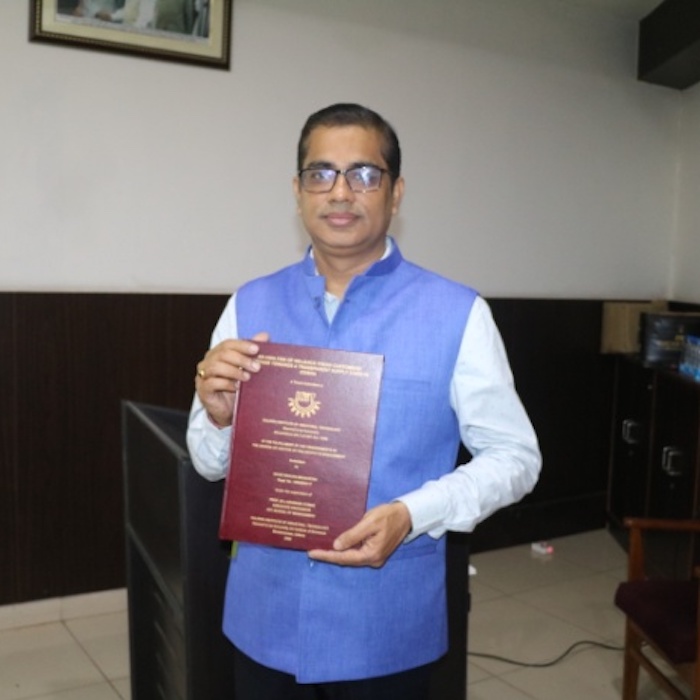
Abstract:
The objective of any business is to gain customers’ confidence and loyalty and customer can only be loyal if they get the same product or service quality uninterruptedly. Products are madeavailable to customer from the manufacturers through a supply chain management system leveraging one or many intermediaries for smooth operation purposes.In recent days there is a massive growth in consumer products worldwide and supply chain management system has helped to make it possible. The consumer products market is valued at USD 711.56 billion in 2019 and is expected to reach USD 935.98 billion by 2025, at a CAGR of 4.6% over the forecast period from 2020 to 2025.The Largest Market for this is North America, and the fasted growing market for tis is Asia Pacific. India is contributing as the 2nd most after china in the Asia pacific growth.However in India there is a new challenge for the manufactures and consumers and this is related to the lack of end to end traceability of the consumer products, these are becoming essential attributed to counterfeiting, promised and delivered quality parameters, proper maintenance of environmental factorsas well as compliance both in transit and at rest.There is a massive increase in customer dissatisfaction which pertains to the product counterfeiting and non-traceability of the products in backward direction. As per figures shared by The Authentication Solution Providers’ Association (ASPA) the FMCG Products are the 2nd most counterfeited category after Currencies in India. A study done by KPMG in India indicates that due to counterfeiting, over 30% of business revenue is affected by branded products and these have increased at a rate of 24% in the last few years.This is not only causing business loss for the manufactures but becoming a matter for consumers as well. The consumers end up paying the products original cost and get substandard products whose quality is compromised due to various unclear and unfair practices. Apart from this these products also causing health hazards for consumes due to non-availability of quality controlassurance in the packaged items.Although manufactures are trying the best to reach out to consumers with best of their products and best in class qualities due to the phase wise distribution steps of traditional supply chain mechanism counterfeited products enter the distribution channel and the customers end up buying those from the different retail units. Customers are generally clueless about the different channels that the product has been through due to lack of information sharing process and once the product is sold the responsibility is not owned by any of the intermediaries in the product supply chain.And use of smart contract mechanism. The study will primarily to analyse consumers’ preference for tracking genuine FMCG products in Odisha and examine the feasibility of a tracking mechanism. The study will be primarily be done in 3 major coastal cities of Odisha Bhubaneswar, Cuttack and Puri due its population density , product proliferation and availability of the RelianceFresh stores in these cities.
Scholar Name- Pramod Misra
Supervisor Name- Dr. Jitendra Mohanty
Thesis Title-Improving Efficiency & Quality through Effective Training; an Exploratory Study on Supervisory Leadership Styles in the Infrastructure Sector
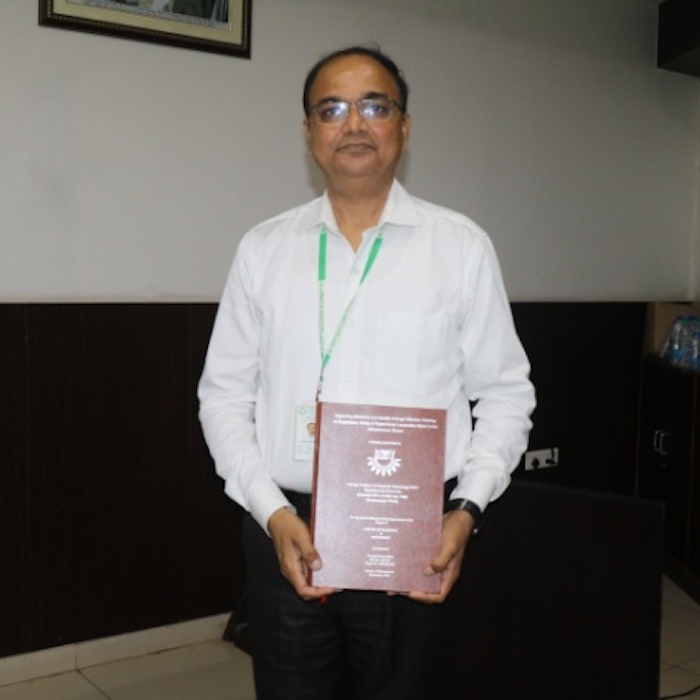
Abstract:
IntroductionSuccessful leadership plays a significant part in any organization’s accomplishments. Leadership position is illustrated whenever people operate in communities and is the chief mechanism by which a community or entity forms and determines its priorities and culture. Today, every manager is expected not only to be an effective leader but also a coach and mentor. Construction industry is not an exception in this regard, especially with respect to the frontline employees, i.e., supervisors and foreman. Supervisors in any construction project are expected to exert a positive influence over the daily performance of their workers. Thus, supervisory leadership is defined as behaviour intended to provide guidance, support and coercive feedback for the day‐to‐day activities of work unit members.Construction sector, which include urban development and real estate is recognized as the India’s 2nd largest employer with around 44 million workforces contributes to India’s 9% GDP share. In last few decades, project-driven paradigm along with innovative technical expertise got projected as major traits of an Effective Construction Supervisory Leadership (ECSL). It is responsible for a broad variety of engineering procedures and administrative activities for any construction project (CP). The timely successful accomplishment of whole project along with its proper resource allocation is heavily dependent on ECSL skills, which renders ECSL as CP’s primary decision-maker. Successful execution of projects in the construction industry requires site-supervisory leaders including other frontline leaders’ versatile managerial and technical expertise.Aim & SignificanceThe present research aims to investigate such prevalent issues of Indian construction industry and analyze the significance of supervisory leadership qualities. It presents a comprehensive strategy to identify and gauge the organizational performance (i.e., efficacy and work quality of the employees) via Employee Attitudinal Measures (EAM). It conducts a critical performance assessment of employee attitudes via survey, fact analysis and data interpretation.The site-supervisory leadership, i.e., supervisors including foremen is considered as the front-line leadership employed in the target company. The work also summarizes the role of Supervisory Leadership Practices (SLP) for improving the corporate efficacy. The constructs considered in the current research is based on SLP as independent variables and EAM as dependent variables. Further, each of these two variables has three major pillars with underlying facets, which was used to formulate a customized survey questionnaire having close-ended questions. Based on the survey responses received from the target population, descriptive statistics of each construct was conducted and thoroughly analyzed.The research also empirically correlates the site-supervisory leadership traits with organizational performance and summarizes its impetus to meet the GOI’s expectations to achieve an aggressive and sustainable growth rate of construction sector. The overall aim of the thesis is to suggest ways and methods for improving the organizational efficacy along with yearning for construction best practices. The research is based on the concept of a ‘Black-Box’ design, where the complex inter-relationship between various aspects related to supervisory leadership practices and organizational performance is properly established and thoroughly examined. It is expected that outcomes of the present work will be useful for the development of leadership qualities in supervisor-level staffs in a typical Indian construction industry through refining the leadership skills by effective training interventions and its proper implementation.Research Objectives1. To study various leadership traits at supervisory-level that should be followed in a typical Indian construction company in order to improve its overall effectiveness.2. To examine how supervisory leadership styles impact the employee attitudinal measures, e.g., morale, organizational commitment, performance and work quality in an Indian construction industry.3. To investigate deeply the level of influence and direction of the association-ship between SupervisoryLeadership Practices (SLP) and Employee Attitudinal Measures (EAM).4. To explore, suggest and implement an effective training program for a construction organization targeting the development of the leadership skills of supervisors in a complex working environment.MethodologyInitially, a pilot study was conducted using some basic questionnaire to fine-tune the survey model. Based on the inferences from the pilot study, extensive survey using properly designed set of questionnaires having three separate sections was conducted. First section comprised of basic demographic analysis, the second section consisted of procedure to identify the effective site-supervisory leadership traits and the final section was consisted of the opinion of employees regarding inclusive training initiatives.Participants were told that there is no right or wrong answers and that they should indicate their choice by the appropriate number (ranging from 1 to 5). A score of 3 would indicate that the individual had mixed attitudes about the choice. A higher score indicates the extent to which the organization uses the SLP best practices and otherwise.Firstly, quantitative findings including descriptive statistics for each of the study variables was explored based on the data collected through the survey. This was followed by a Bivariate analysis to test the relationships between the study variables under consideration. The study used correlations to test the association, as well as hierarchal multiple regression analysis to examine the net effect of each of the supervisory leadership practices (SLP) bundles on the employee attitudinal measures (EAM) bundles.The study also reported the correlation coefficients between each bundle of SLP and EAM. All statistical analyses were performed using the Statistical Package for the Social Sciences (SPSS). Preliminary statistical analyses consisted of descriptive statistics for all study variables, as well as Cronbach’s alpha internal consistency reliability coefficients for the employee questionnaire sub-scales. Then, hypotheses were tested using stepwise hierarchal multiple regression analysis to estimate the net effect of each of the independent variables.The present study also attempts to investigate and provide empirical evidence on the impact of these SLPs on EAMs by answering the research question, “How supervisory leadership practices impact the employee attitudes measures in a typical Indian construction industry measured via overall performance, efficiency & quality-of-work?” These hypotheses were tested using Hierarchical Multiple Linear Regression (HMLR) analysis with an objective to estimate the net effects of each of the independent variables on the dependent variables. These variables were measured using suitably designed questionnaire, which were appropriately prepared based on the unique facets under consideration. Few standard sets of questionnaires were studied as a part of the literature review, which served as a platform for the design and operationalization of the customized questionnaire used in the present survey. These standard questionnaires were “Organizational Commitment Questionnaire (OCQ)”; “Job Satisfaction Questionnaire (JSQ)” and “Motivational & Retention Factor Questionnaire (MRQ)”. FindingThe research revealed that transactional leadership style had a negative influence on one of the EAM, i.e.,Performance & work quality, whereas, transformational leadership style (TFLS) had a positive impact on all the three bundles of EAM. It was also revealed that supervisory leadership practices like supportive leadership, contingent reward and management by exception are extensively being followed in the current organization, whereas the practice of Laissez-Faire leadership skills is least. There were few neutral responses also like articulating a vision, inspirational communication, intellectual stimulation, personal recognition. These responses need to be explored more and related best practices need to be reinstated within the organization.ConclusionIt was concluded that the organizations should pay more attention to employees’ promotion, career growth and equal job responsibilities of all the employees. Leaders should understand whether their leadership style is positively or negatively affecting the employees. The higher-level management needs to train all site-supervisors in transformational leadership skills within the organization and the use of these styles must associate with the employees’ values and concerns.
Scholar Name- Kumari Akriti
Supervisor Name- Dr. Ipseeta Satpathy
Thesis Title-A Comparative Study on Employee Retention in Public & Private Sector Banks
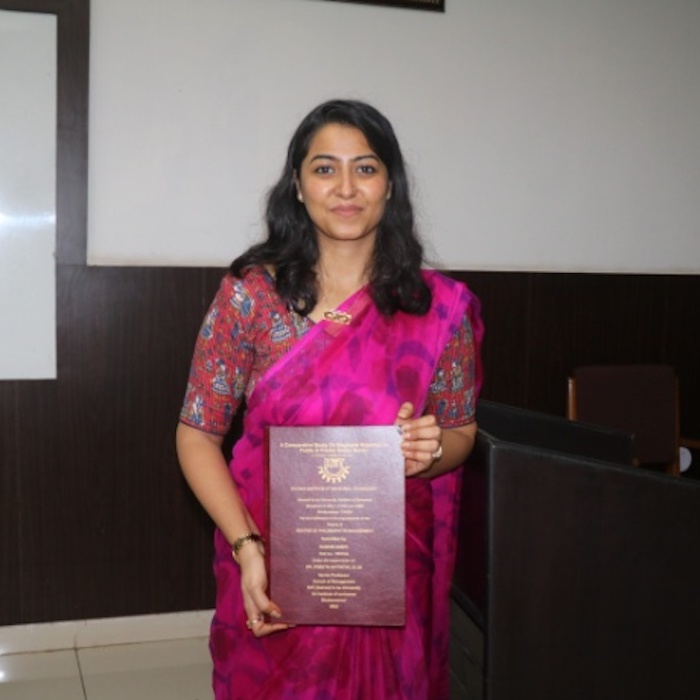
Abstract
Employee Retention is a process where employees choose to stay with their organization and does not look for other job options while turnover means where employees leaves theorganization due to various reasons. Employee Retention involves implementation of all thestrategies that will lead to retaining the employees for longer duration. The use of internal employability to reduce employee turnover considering the current unemployment rate and compensation paid to the employees. Internal Employability means providing training and goodCareer change opportunity within the organization (Manjavacas A S, 2014, et al). The major reasons for leaving a job is job satisfaction and job alternatives which means if a person is engaged and empowered then he is more likely to stay and if he has option available outside then he less like to stay, attitude of an employee which means an inclination towards an organisation as a whole rather than just for a job (Lee T W, 2017, et al). Organization tries to identify their human assets who contribute in achieving organization’s goal and build their strategies to retain them for maximum tenure.The importance of leadership roles, Organizational reputation, Corporate Social Responsibility and stakeholder culture in retaining the employees. ResponsibleLeadership can be explained as someone who includes everyone in attaining their team goals and provides extended support to their subordinates (Doh J P, 2011,et al).The HR managers of the firm should be able to show the career graph of the employees and what better can be done to retain them and get rid of all their apprehensions during the crisis. The main factors which affected an individual’s decision are Autonomy, Compensation, Employee Engagement, Goal Clarity and Normative Commitment. As if these factors are taken into consideration then organization will be successful in retaining their employees up to some extent and save their investment cost (Ghosh P, 2013, et al).Banking Sector faces a lot of challenges in retaining the employees. Considering the growth opportunities and employability in this sector it has a huge role to play in retaining the employees. There are a lot of factors that can be explored in this study which might be helpful in retaining the employees of the selected banks which will be considered while conducting the study.This study will be a comparative study between public and private sector banks to study the different factors affecting the retention ratio. The study will also cover the impact of Covid-19 on employee retention in the selected public and private banks. The data will be collected from in and around Bhubaneswar. The respondents will be those employees who have experience of more than 2 years in the same organization.This research will help in identifying the factorswhich will further help in fulfilling the gaps that has been identified during the study. The studywill also emphasize and highlight the importance of remedial actions to further improve theretention level of the employees and enhance their quality of work life.Keywords: Employee Retention, Employee Engagement, Internal Employability, Corporate,Banking Sector
Scholar Name- Biswa Bhusan
Supervisor Name- Dr. Ashok Kumar Sar
Thesis Title: – Impact of Training on developing skills: A study of Indian IT industry
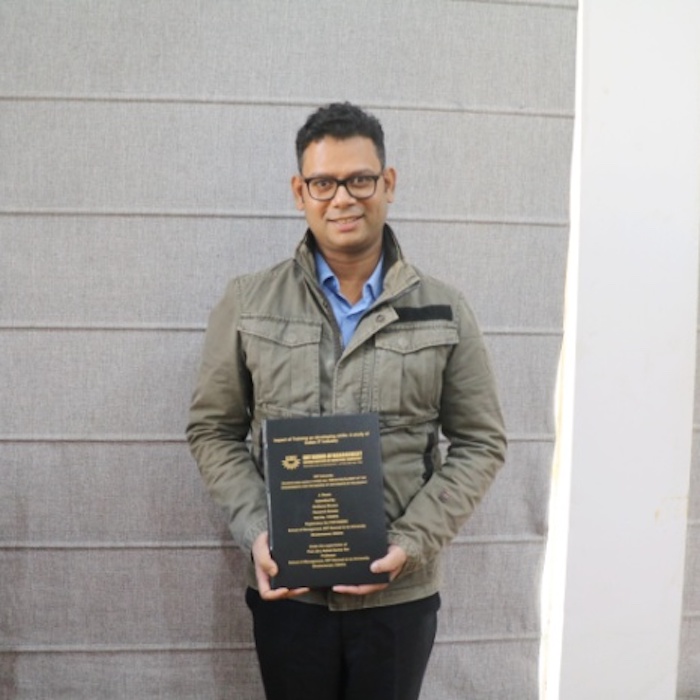
Abstract:
IT companies spend 4-6% of revenue annually on training their employees. It is important toquantify the results of training as it takes time to see the impact of training in developing skills. Unless training and staff development are completed, organizations cannot succeed as the skills required for IT and ITES tasks have been changing fast in general and from project to project in particular. Improving skills enhances workers' productivity and adaptability which contributes to the necessary level of success. Training is designed to allow an individual to learn new abilities, expertise, ideas, roles, and conduct quickly and successfully in the employee’s current work. This is possible because of skill enhancement.There are different types of training delivery and there are different types of skills one can acquire. The mode of training even has impact on various types of skills. The research attempted to explore how training is important to develop skills; which is a fundamental aspect of individual and organizational growth in the Indian IT organizations. The study explores the drivers of skills, such as different modes of training and extent of impact of these drivers on different type of relevant skills.For the research purpose, top four IT companies, such as, TCS, CTS, Accenture and Wipro are considered and 408 employees had filled the questionnaire. 389 responses are considered for the study. The responses were recorded in five point Likert scale. To analyze demographic and general information, descriptive statistics is used. To identify the relevant research variables, Factor Analysis (Principal Component Method) is done, Cronbach Alpha calculated for reliability of the constructs and KMO Bartlett test/ PCA are used to measurethe validity of the questionnaire. Hypothesis (which were formed after literature review), were tested using correlation and regression.From the findings, classroom training was found to be most appropriate for developing managerial skills. Similarly, application based training was found to be most appropriate for developing technical skills as well as life skills. Other modes of training were found to beless appropriate for developing skills.This study brings out meaningful insights on skill development for an industry where theknowledge-base is expanding rapidly requiring updated skills to be successful. Insightsgained from the study can be used to customise training to develop skills considering thenature of skills. This can help business and training managers to develop relevant skills moreeffectively and efficiently by mapping the trainees with training modes and skill types.


